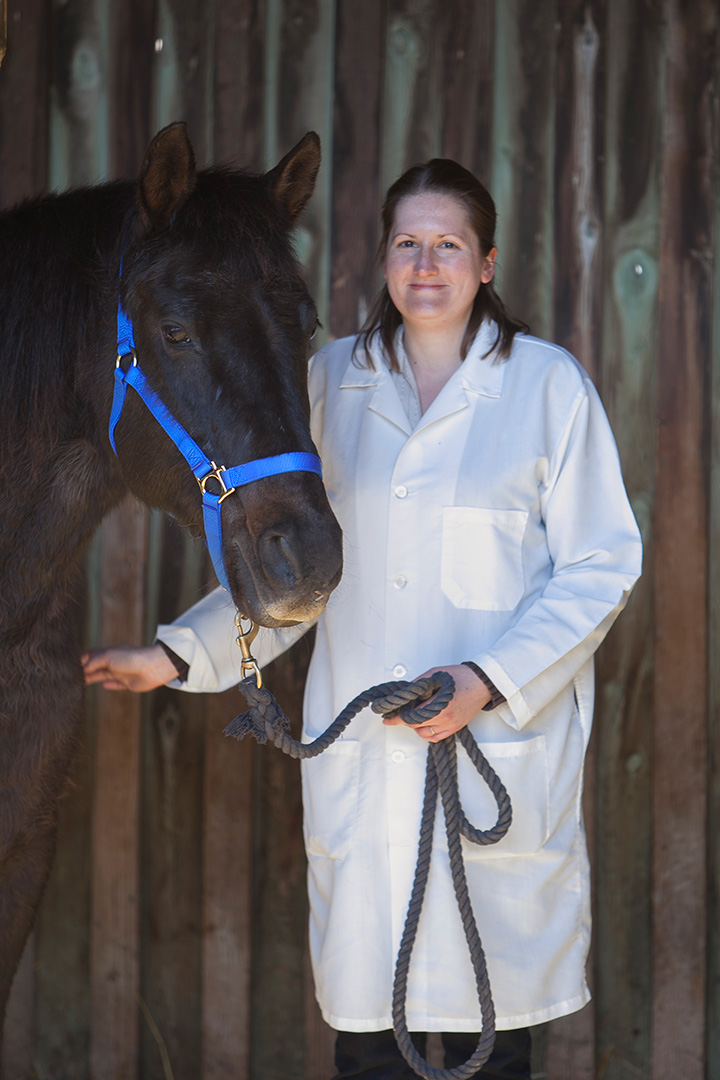The limb chill factor: study explores cold therapy options for laminitis
University of Saskatchewan (USask) researchers hope their recent review of previous studies assessing different types of cold therapies for preventing and treating equine acute laminitis will help veterinarians and serve as a starting point for the design of a new cost-effective cooling boot.
By Cat Zens“This review can help veterinarians make decisions on which methods to attempt and which methods to maybe just stay away from — even if they may be more convenient,” says Dr. Julia Montgomery, a specialist in large animal internal medicine and a professor at the Western College of Veterinary Medicine (WCVM)
The research team’s paper, which was recently published in the Veterinary Journal, evaluated the effectiveness of different types of continuous digital hypothermia (CDH) for preventing and treating laminitis — a painful and potentially career-ending disease in horses. These interventions are also described as cryotherapy (cold therapy).
“If you are a clinician in the field and you don’t know if you have a horse with this disease, you don’t know which techniques you can use to cool down these [the patient’s] hoofs. You don’t know the parameters that you need to follow to give the best treatment,” says Ronaldo Avella Lavado, a USask graduate student and the paper’s lead author.
“We decided to publish [this review] for all the researchers and clinicians who may be interested in knowing them."
Laminitis affects the lamellae of a horse’s hoof. When these tissues are inflamed, damage to the connection between the tissue and the hoof occurs, causing local pain. This pain leads to horses being unable to move properly. If left untreated, damage can worsen over time. Ideally, clinicians aim to prevent laminitis in horses at risk.

“It is a very complicated disease to understand and treat,” Lavado says. “With the hours and days passing by since the first clinical signs, it’s harder to treat it and avoid further damage. That’s why it is so important to begin cryotherapy (CDH) treatment as soon as possible.”
CDH helps cool down an animal’s tissues to reduce tissue damage, inflammation and pain. Laminitis inflames the tissue through the effusion of harmful molecules and cells, affecting blood flow. As cooling decreases the blood flow circulation and metabolism of the affected region, less harmful molecules are produced — making CDH a standard preventive intervention for the disease.
When using CDH to prevent or treat equine laminitis, veterinarians cool a horse’s hoofs below 10 C for approximately 18 to 72 hours. Lavado also recommends that the treatment continue for 24 to 48 hours after signs of inflammation recede.
Lavado emphasizes that CDH is more effective as a preventive tool than as a treatment for an already existing condition.
“When you have a horse that is prone to develop laminitis, you should quickly use cryotherapy and avoid the development or worsening of the limbs as soon as possible, and not wait until the horse … already has clinical signs to begin treating it,” Lavado says. “If you wait too long, the treatment is not going to be as effective as if you did it before.”
CDH is also a safe option, so even if the therapy is used on a horse that doesn’t have laminitis or isn’t prone to developing the disease, cryotherapy won’t have negative effects when employed properly, Lavado says.
The team’s published review includes various CDH methods ranging in cost and efficiency along with the animals’ reactions to the different treatments. Options range from simply putting a horse’s limb in a plastic bag of ice to using commercially available rubber ice boots designed for horses undergoing cryotherapy.

More intricate CDH methods also exist, such as cross-therapy pads that work with artificial ice. Another example is the perfused cuff prototype, a type of boot with a coolant recirculating inside. But these cold therapy methods come with limitations: most CDH options are labour-intensive, timely and heavily reliant on ice, which isn’t always available on farms or in clinical settings. More technological methods can also be cost-prohibitive and need specialized personnel to develop.
To address these limitations and complications, Montgomery and her collaborators are using the review’s data to develop a more user-friendly and affordable cooling boot in partnership with RMD Group of Companies, a Saskatoon-based cluster of companies.
“[The new cooling boot] can maybe be used in an ambulatory setting that doesn’t require as much people power and moves away from the need for ice but still reaches the parameters that are clinically needed to actually be effective,” says Montgomery.
Cat Zens of North Battleford, Sask., is a fourth-year student in the University of Regina’s School of Journalism. She worked as a WCVM research communications intern in 2023.
Click here to read more equine health stories in the Spring 2024 issue of Horse Health Lines, newsletter for the Townsend Equine Health Research Fund (TEHRF).
